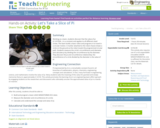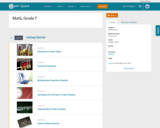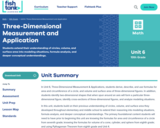
A deep dive into the area and circumference of circles.
A free CK-12 account is required to view all materials.
- Subject:
- Mathematics
- Material Type:
- Lesson
- Provider:
- CK-12 Foundation
- Provider Set:
- CK-12 Geometry
- Date Added:
- 10/02/2022

A deep dive into the area and circumference of circles.
A free CK-12 account is required to view all materials.

Working as a team, students discover that the value of pi (3.1415926...) is a constant and applies to all different sized circles. The team builds a basic robot and programs it to travel in a circular motion. A marker attached to the robot chassis draws a circle on the ground as the robot travels the programmed circular path. Students measure the circle's circumference and diameter and calculate pi by dividing the circumference by the diameter. They discover the pi and circumference relationship; the circumference of a circle divided by the diameter is the value of pi.


Zooming In On Figures
Unit Overview
Type of Unit: Concept; Project
Length of Unit: 18 days and 5 days for project
Prior Knowledge
Students should be able to:
Find the area of triangles and special quadrilaterals.
Use nets composed of triangles and rectangles in order to find the surface area of solids.
Find the volume of right rectangular prisms.
Solve proportions.
Lesson Flow
After an initial exploratory lesson that gets students thinking in general about geometry and its application in real-world contexts, the unit is divided into two concept development sections: the first focuses on two-dimensional (2-D) figures and measures, and the second looks at three-dimensional (3-D) figures and measures.
The first set of conceptual lessons looks at 2-D figures and area and length calculations. Students explore finding the area of polygons by deconstructing them into known figures. This exploration will lead to looking at regular polygons and deriving a general formula. The general formula for polygons leads to the formula for the area of a circle. Students will also investigate the ratio of circumference to diameter ( pi ). All of this will be applied toward looking at scale and the way that length and area are affected. All the lessons noted above will feature examples of real-world contexts.
The second set of conceptual development lessons focuses on 3-D figures and surface area and volume calculations. Students will revisit nets to arrive at a general formula for finding the surface area of any right prism. Students will extend their knowledge of area of polygons to surface area calculations as well as a general formula for the volume of any right prism. Students will explore the 3-D surface that results from a plane slicing through a rectangular prism or pyramid. Students will also explore 3-D figures composed of cubes, finding the surface area and volume by looking at 3-D views.
The unit ends with a unit examination and project presentations.

Students will measure the circumference and diameter of round things in the classroom and discover the ratio pi. They will see that the ratio of a circle's circumference to its diameter can be used to solve for the circumference when the diameter is known.Key ConceptsStudents have seen circles before, but have not analyzed the relationships between parts of a circle. The ratio of the circumference to the diameter is pi, about 3.14 or about 227. Students see that all of the objects they measure have this ratio (or close, depending on accuracy) and that the ratio is true for all circles. Students also see that the ratio can be used to solve for the circumference of a circle if the diameter (or radius) is known.GoalsMeasure round things looking for similarities.Find the ratio of the circumference to the diameter of those round things.Find a formula to find the circumference of a circle.SWD: Make sure students understand these domain-specific terms:It may be helpful to preteach these terms to students with special needs. If possible, reinforce the definitions of these terms with visual supports (diagrams).ELL: As new vocabulary is introduced, be sure to repeat it several times and to allow students to repeat after you as needed. Write the new words as they are introduced and allow enough time for ELLs to check their dictionaries or briefly consult with another student who shares the same primary language if they wish.ratiocircumferencecirclediameterscatter plot

This multimedia site offers a beginner's guide to understanding the relationship between the diameter and circumference of a circle. This Learn Alberta site offers a video [1:44], interactive exercises and printable extended exercises.

A complete reference guide to circles including parts, angles, and arcs. It provides definitions and interactive activities that enhance further explanation.

Sports such as hockey, football, basketball and tennis use balls of different sizes. Can you arrange a selection of different balls in a line each touching the next to make the shortest line? This activity offers opportunities for creative thinking and problem solving and helps pupils to understand the properties of circles. It can be presented using your school's own sports equipment and is aimed at primary school pupils (Key Stage 2).

This lab activity allows students to calculate the diameter of the moon using proportions. Also follow links to other NASA lesson plans.

Gain an understanding of how to find the diameter of a circle by viewing an example and a video lesson. [1:01]

University of Nottingham astronomers talk about telescope diameter, and how the size and quality of a telescope's mirror determine what we see when looking through it. Offers a look at the opportunities offered by the "Extremely Large Telescope", which will be built with a lens over forty meters in diameter. [8:31]

Students extend their understanding of circles, volume, and surface area into modeling situations, formula analysis, and deeper conceptual understandings.

Find a quick, concise explanation of what the diameter of a circle is. An example is given and clearly explained.

It's easy to find the circumference of a circle if you know the diameter. Just plug in its value into the formula for the circumference of a circle to get the answer. This tutorial shows you how. [3:28]

The circumference of a circle is the distance around that circle. Take a look at this tutorial to discover the formulas for the circumference of a circle. [4:22]